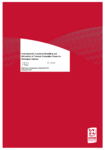Tsunami Inundation Modelling and evacuation zones for Wellington Harbour 2015
Search in document library
Purpose to model tsunami inundation scenarios and define evacuation zones for Wellington Harbour to support emergency planning and public safety.
Geographic Coverage: Wellington Harbour and surrounding coastal areas including Petone, Eastbourne, and the Wellington CBD.
This report presents the results of tsunami inundation modelling for Wellington Harbour, conducted by GNS Science in 2015. The modelling aims to understand how different tsunami scenarios could affect the harbour and its surrounding communities. It also defines evacuation zones to help guide emergency response planning and public safety measures.
The study uses computer simulations to model tsunami waves generated by large earthquakes in various locations, including local New Zealand faults and distant sources such as South America. These simulations estimate how far inland tsunami waves could travel, how deep the water might be, and which areas are most at risk.
Three evacuation zones are defined: red, orange, and yellow. The red zone includes areas that could be flooded by a small tsunami and should be evacuated immediately after a strong earthquake. The orange zone covers areas that may be affected by a moderate tsunami, and the yellow zone includes areas at risk from a large tsunami. These zones are designed to help people know when and where to evacuate depending on the severity of the event.
The modelling shows that low-lying coastal areas such as Petone, Eastbourne, and parts of the Wellington CBD are particularly vulnerable to tsunami inundation. In some scenarios, water could reach several hundred metres inland, with depths exceeding one metre in certain locations. The timing of the tsunami waves also varies, with locally generated tsunamis arriving within minutes and distant-source tsunamis taking several hours.
The report highlights the importance of public awareness and preparedness. Because locally generated tsunamis can arrive quickly, there may be little time for official warnings. People should evacuate immediately if they feel a strong or long earthquake. For distant-source tsunamis, there is more time to issue warnings and coordinate evacuations.
The findings support the development of evacuation maps and signage, and inform emergency management planning by local authorities. The report also recommends ongoing education and drills to ensure communities understand the risks and know how to respond.
Overall, the report provides valuable insights into tsunami hazards in Wellington Harbour and offers practical guidance to reduce risk and enhance public safety.
